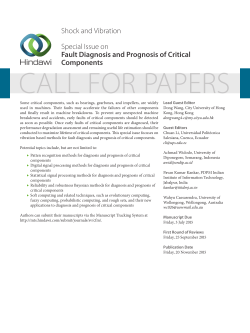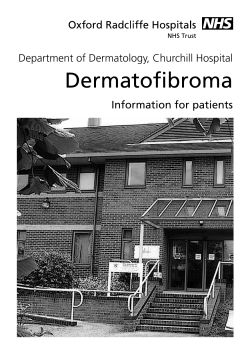
Can Strict Criteria Improve Diagnostic Concordance Among
INTRODUCTION Histologic exam of bone specimens coupled with bone culture is considered the gold standard for diagnosis of osteomyelitis (OM) ; however, pre-procedural antibiotic administration and soft tissue contamination limit utility of bone cultures, leaving histologic diagnosis to stand alone. The presence of residual OM in an amputation margin results in non-healing wounds and/or further amputation in 40-47% of patients, and yet few studies have explored the effectiveness of histologic exam of bone specimens in the diagnosis of OM, there is no standard criteria for diagnosis, and there is no definition of chronic OM. Lastly, diagnostic concordance among pathologists is as low as 30% . In a previous study, we defined and weighted 13 histologic criteria based on the literature (see Table 1). Using those criteria, we reviewed 385 slides of bone specimens with the following results: • • • • • • If the original diagnosis was OM, the criteria based diagnosis was OM Patients with discordant diagnoses were more likely to fail treatment: 74.39% vs 42.06%; relative risk = 1.77; p = 0.00001 The majority of diagnostic discordance was chronic OM, where an original diagnosis utilized a description of chronic OM, but ultimately read as “No Acute Osteomyelitis Identified” Bone cultures were rarely performed due to pre-procedural antibiotic administration (20%) Peripheral vascular disease was an independent risk factor for treatment failure Finally, scores based on weighted criteria suggested potential to indicate the specific type of OM present, with histologic findings scoring 4 points or less being diagnostic of no osteomyelitis, and scores ≥6 points indicating a diagnosis of OM We concluded that descriptive diagnoses of OM do not prompt clinicians to modify treatment, and chronic OM is under diagnosed. In this study, we sought to determine if our criteria could improve diagnostic concordance among pathologists with results similar to our previous study. CONCLUSION Histologic Criteria • The diagnosis of osteomyelitis is difficult. Lack of definitive criteria and definitions for diagnosis are significant contributors to this diagnostic dilemma. We have developed a histopathological tool that demonstrates clinical significance in the diagnosis of osteomyelitis in the foot and ankle, and suggests potential to reduce rates of treatment failure. In addition, our tool has shown potential to dramatically improve diagnostic concordance among pathologists, even in the absence of clinical information. Major (3 points) - Acute Neutrophils Abscess Fibrinoid Necrosis • Scores and variations in scores may help pathologists better determine the specific type of osteomyelitis, and duration of infection. Bacteria - Chronic Sequestrum Involucrum Figure 1: Involucrum Figure 2: Micro-Sequestrum Intermediate (2 points) Marrow Fibroplasia Minor (1 point) Erosion Remodeling • Recognizing involucrum and sequestrum is essential to the diagnosis of chronic osteomyelitis. These are also some of the more difficult histologic features to recognize (Figures 3 & 4). Granulation Tissue Chronic Inflammation • Charcot Arthropathy and chronic/non-healing fracture can have deceptively similar appearances to chronic osteomyelitis. In difficult cases, clinical history and radiologic findings should be reviewed before rendering a diagnosis of chronic osteomyelitis. Destruction Necrotic Bone Table 1: Histologic Criteria Figure 3: Involucrum Figure 4: Bone Dust DISCLOSURES & ACKNOWLEDGMENTS RESULTS We have no financial or non-financial disclosures. Agreement: • Overall concordance among the 6 pathologists was 84% DESIGN • Agreement per the specific type of OM was 73% with the greatest disagreement being AOM vs ACOM • 6 pathologists with experience ranging from 1 to 39 years were recruited to review 35 slides • All 6 pathologists diagnosed the AOM control as AOM, and the Plasmacytoma as a Neoplasm • 30 slides from cases of suspected OM of the foot and ankle were selected: • All 6 pathologists diagnosed the ACOM control as AOM and failed to recognize both involucrum and micro-sequestrum in this slide (Figures 1 & 2) ₋ ₋ ₋ All cases were originally diagnosed as “No Acute Osteomyelitis Identified” Patients with a history of peripheral vascular disease were excluded 5 additional control slides were selected, with original diagnoses as follows: 1. Plasmacytoma 2. Fracture 3. Charcot Arthropathy 4. Acute Osteomyelitis* 5. Acute and Chronic Osteomyelitis* • Each pathologist was provided with an outline from the previous study, definitions of histologic criteria, color photocopies and electronic photographs of the histologic criteria, and a tabulation sheet for each slide. • Pathologists were asked to mark the presence of each histologic criterion, and make a diagnosis; however, a diagnosis of OM had to meet the minimum following requirements: ₋ ₋ ₋ ₋ Acute OM (AOM): a minimum of one major acute criterion Chronic OM (COM): a minimum of one major chronic criterion Acute and Chronic OM (ACOM): a minimum of one major acute and one major chronic criterion No OM Identified (NOM): absence of all major criteria • 2 pathologist diagnosed the Charcot Arthropathy control as COM and one pathologist diagnosed the Fracture control as COM Pathologist AOM COM ACOM NOM The Score: • The ranges of scores for each diagnosis were often wide; however, there was a mean 4.38 point difference in score for each pathologist between a diagnosis of NOM to a diagnosis of OM (Table 2); p <0.05 A B C D E F • Pathologists with fewer years experience had slightly higher overall scores 6.38 6.29 6.83 8.8 5.38 5.33 6.33 5.75 8.36 9.38 7.75 4.57 10 11.37 12.2 12 9 7.5 1.75 1.71 3.11 3.8 1.32 1 Table 2: Mean Scores by Diagnosis The Survey: • The majority of pathologists said they rarely, if ever, make a definitive diagnosis of COM, and instead use descriptive diagnoses; however, 100% stated they believed COM was a histologic diagnosis • 100% felt the criteria would be useful for diagnosing OM in the future • Pathologists were encouraged to consider a diagnosis other than OM, even if a major criterion was present. • 67% stated they would have preferred a lecture in addition to the printed and electronic material prior to beginning this study • Pathologists were not given access to any clinical history, radiology or patient outcomes Patient Outcomes: • Although similar patient outcomes were seen as in the previous study, such as higher numbers of postprocedural amputations in patients originally diagnosed with NOM but diagnosed with OM during this study, only 30 patients were examined for this study, as opposed to the 259 patients in the previous study. Given clinical significance was already demonstrated (p = 0.00001), additional patients were not added to this study. • Upon completion of the slide review , each pathologist completed a post-study survey • Diagnoses from each pathologist were compared for agreement, score, and patient outcomes, and compared with survey responses *The control slides of with an original diagnosis of osteomyelitis satisfied the criteria • Chronic osteomyelitis is one of the primary causes of diagnostic discordance, and is underdiagnosed. We have defined chronic osteomyelitis as the presence of sequestrum and/or involucrum with marrow fibroplasia, bone remodeling, chronic inflammation, and granulation tissue; however, this definition must be explored further, and consensus in the pathology community is needed. In the interim, descriptive diagnoses should include the presence of involucrum and/or sequestrum when present, and include a differential diagnosis of chronic osteomyelitis to help clinicians direct further treatment. Thank you to the 6 pathologists who graciously volunteered as subjects for this study, and the support of the Pathology Department over the last 2 years of this project . REFERENCES 1.Meyr AJ, Singh S, Zhang X, Khilko N, Mukherjee A, Sheridan MJ, Et Al. Statistical reliability of bone biopsy for the diagnosis of diabetic foot osteomyelitis. J Foot Ankle Surg. 2011;50:663–667. 2.Simpson AH, Deakin M, Latham JM. Chronic osteomyelitis. The effect of the extent of surgical resection on infection-free survival. J Bone Joint Surg Br. 2001; 83.3: 403-407 3.Jeffcoate W, Lipsky B. Controversies in diagnosing and managing osteomyelitis of the foot in diabetes. Clin Infect Dis. 2004; 39: S115-S122 4.Bamberger D, Daus G, Gerding D. Osteomyelitis in the feet of diabetic patients: Long-term results, prognostic factors, and the role of antimicrobial and surgical therapy. Am J of Med. 1987; 83.4: 653-660 5.Kowalski T, Miki M, Sorenson M, Gundrum J, Agger W. The Effect of Residual Osteomyelitis at the Resection Margin in Patients with Surgically Treated Diabetic Foot Infections. J Foot Ankle Surg. 2011; 50: 171-175. 6.Anakwenze O, Milby A, Gans I, Stern J, Levin LS, Wapner K. Foot and Ankle Infections: Diagnosis and Management. J Am Acad Orthop Surg. 2012; 20:684-693 7.Cecilia-Matilla A, Lazaro-Martinez JL, Aragon-Sanchez J, Garcia-Marales E, Garcia-Alvarez Y, Beneit Montesinos JV. Histopathology of bone infection complicating foot ulcers in diabetic foot. J Am Podiatr Med Assoc. 2013: ; 24-31 8.Fleisher AE, Didyk AA, Woods J, Burns SE, Wrobel JS, Armstrong DG. Combined clinical and laboratory testing improves diagnostic accuracy for osteomyelitis in the diabetic foot. J Foot Ankle Surg. 2009; 48.1 9.Brem H, Sheehan P, Boulton A. Protocol for treatment of diabetic foot ulcers. Am J of Surg. 2004; 187: 1S-10S 10.Ignatiadis I, Vassiliki T, Papalois AE. A systematic approach to the failed plastic surgical reconstruction of the diabetic foot. Diab Foot & Ankle. 2011; 2:6435 11.Klein M, Bonar SF, Freemont T, Vinh T, Lopez-Ben R, Siegel H, Siegal G. Atlas of Nontumor Pathology: Non-Neoplastic Disease of Bones and Joints (1st Series, Fascicle 9). 2011. American Registry of Pathology. Washington, DC. 12.Wold L, Unni K, Sim F, Sundaram M, & Adler CP (Eds). Atlas of Orthopedic Pathology (3rd ed). 2008. Mayo Foundation for Medical Education & Research (2008). Saunders Elsevier. Philadelphia, PA. 13.Jennin F, Bousson V, Parlier C, Jomaah N, Khanine V, Laredo JD. Bony sequestrum: a radiologic review. Skeletal Radiol. 2011 Aug;40(8):963-75. 14.Mutluoglu M, Sivrioglu AK, Eroglu M, Uzun G, Turhan V, Ay H, Lipsky BA. The implications of the presence of osteomyelitis on outcomes of infected diabetic foot wounds. Scand J Infect Dis. 2013 Jul;45(7):497-503. 15.Senneville E, Melliez H, Beltrand E, Legout L, Valette M, Cazaubiel M Cordonier M, Caillaux M, Yazdanpanah Y, Mouton Y. Culture of percutaneous bone biopsy specimens for diagnosis of diabetic foot osteomyelitis: concordance with ulcer swab cultures. Clin Infect Dis. 2006; 42.1:57-62. Epub 2005 Nov 21. 16.Kumar V, Abbas A, Fausto N. Robbins and Cotran Pathologic Basis of Disease. 2005. Elsevier Saunders, Philadelphia, PA. pp. 3-47
© Copyright 2025









